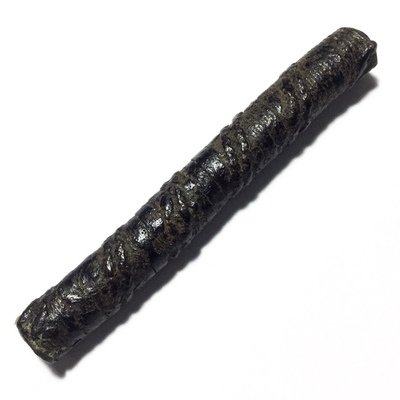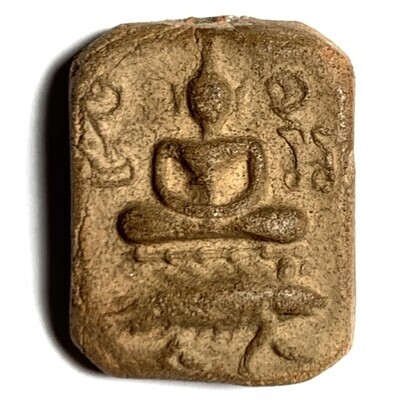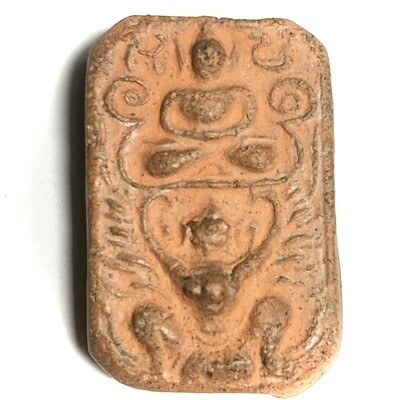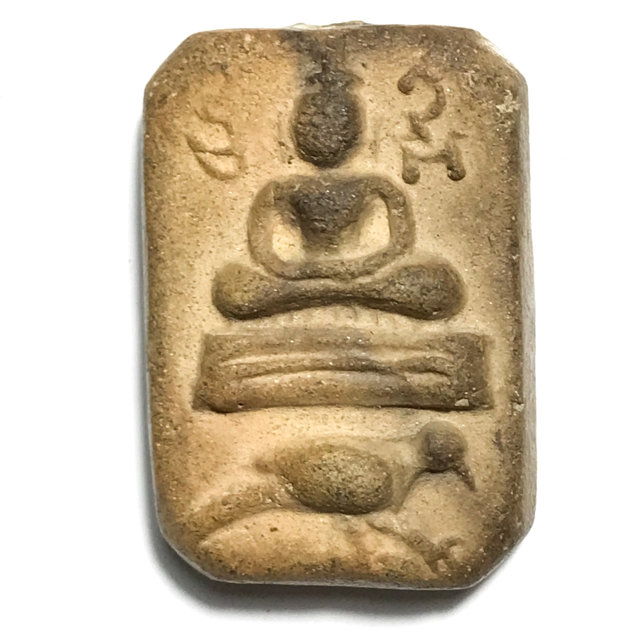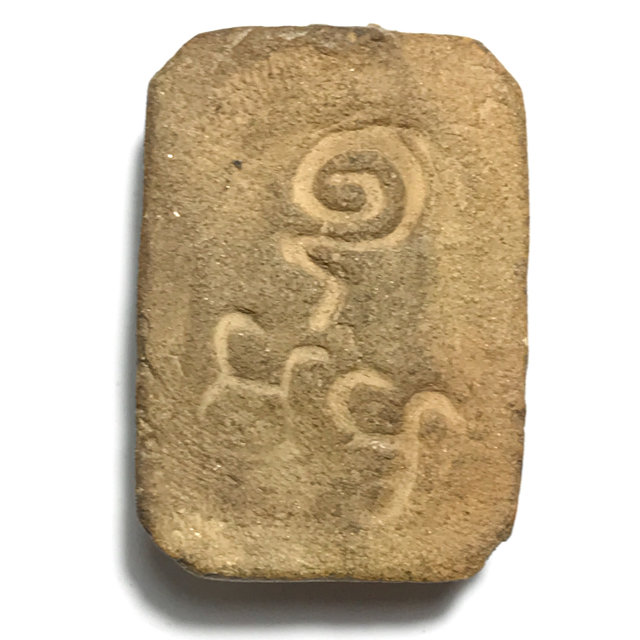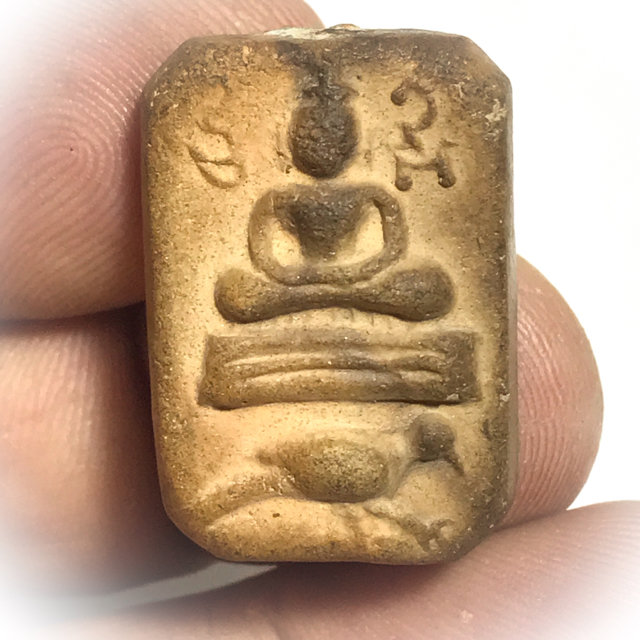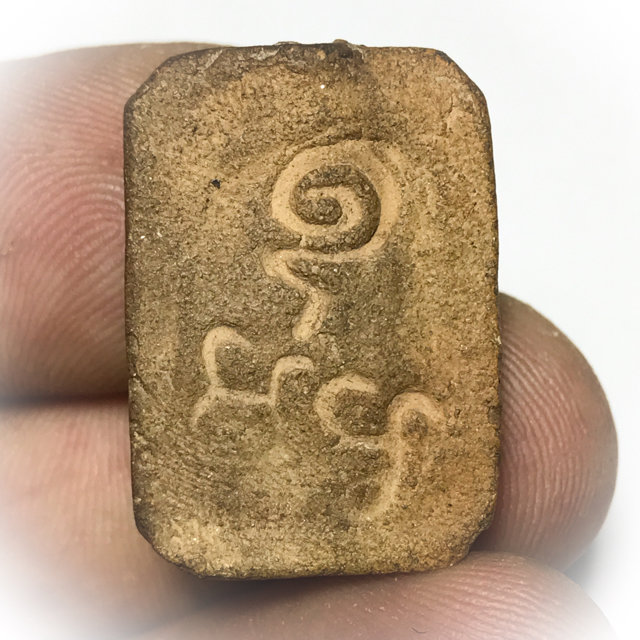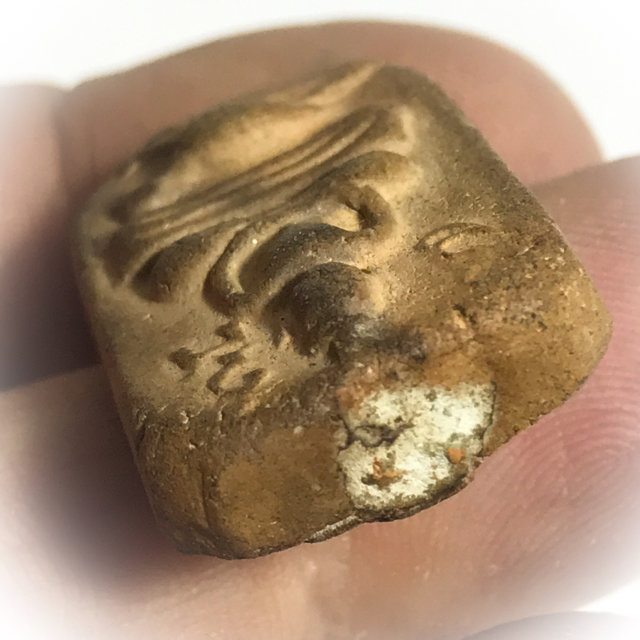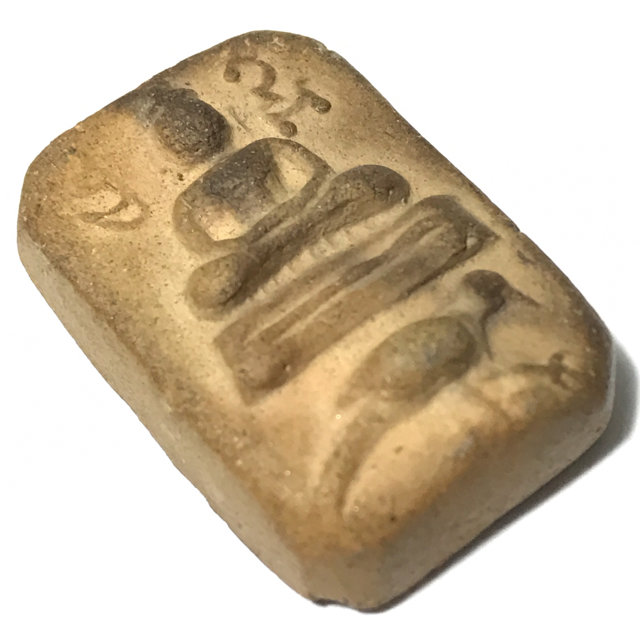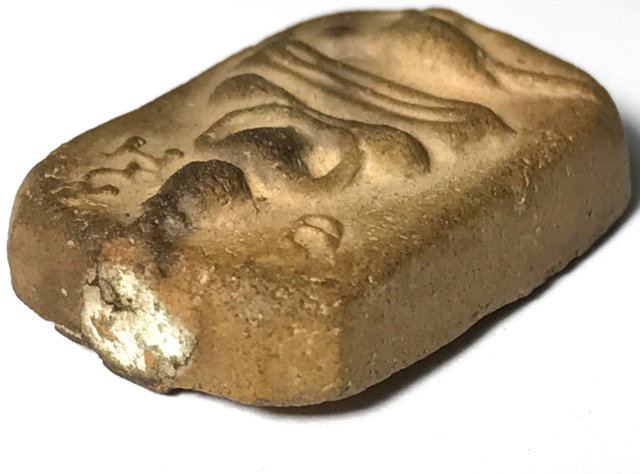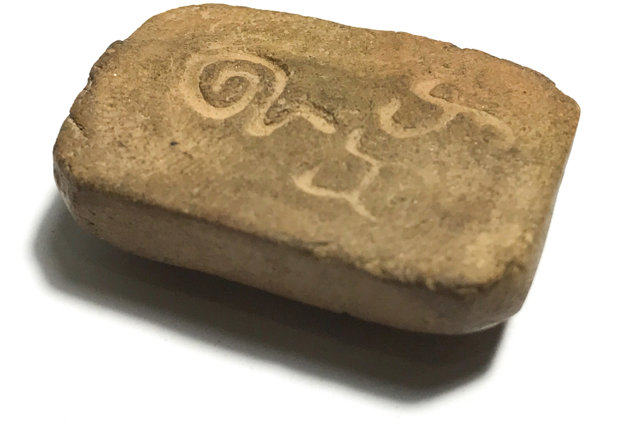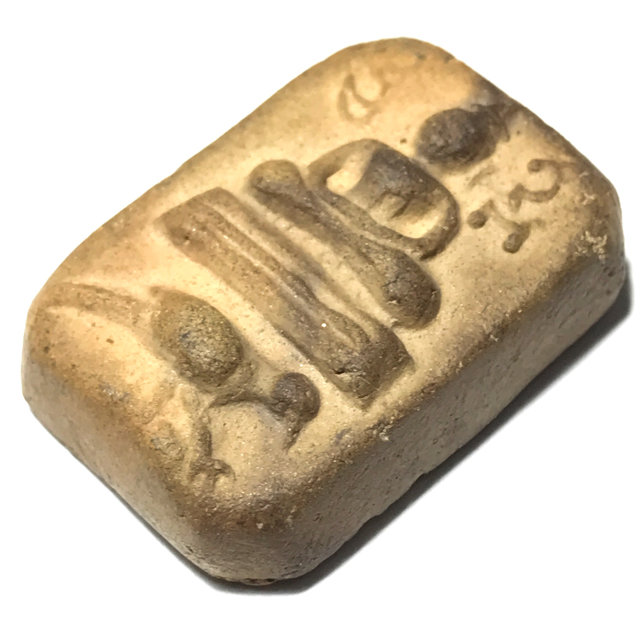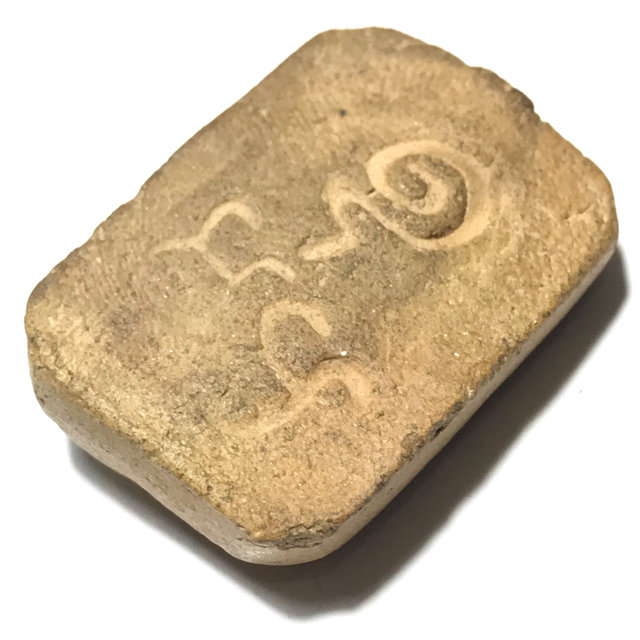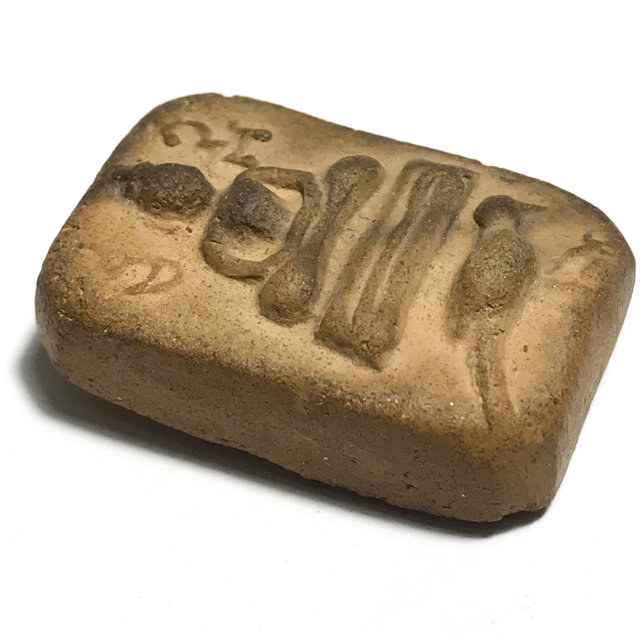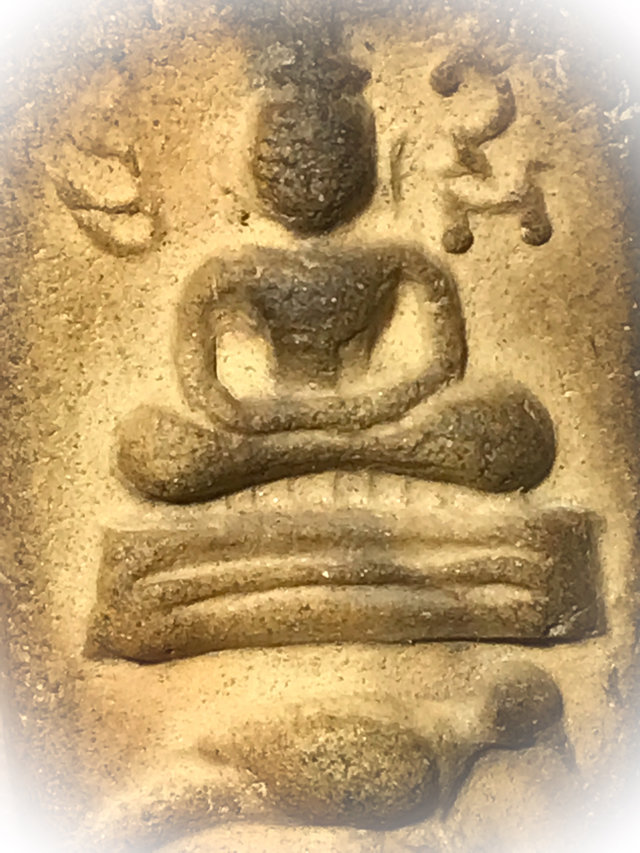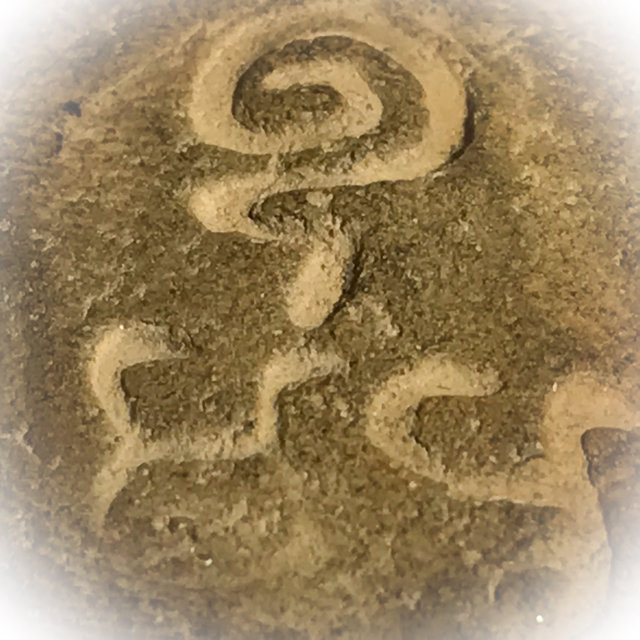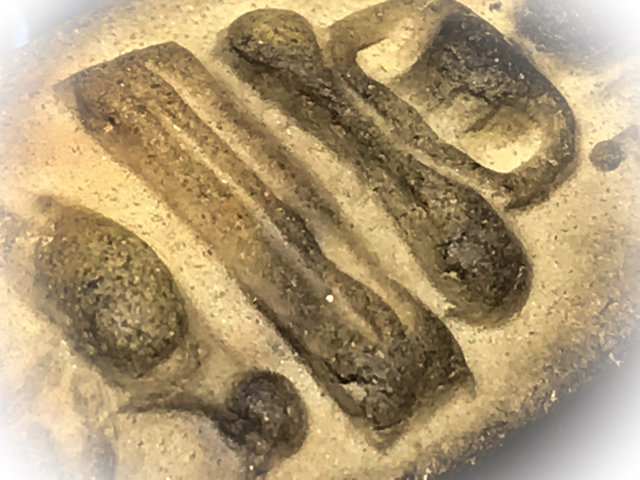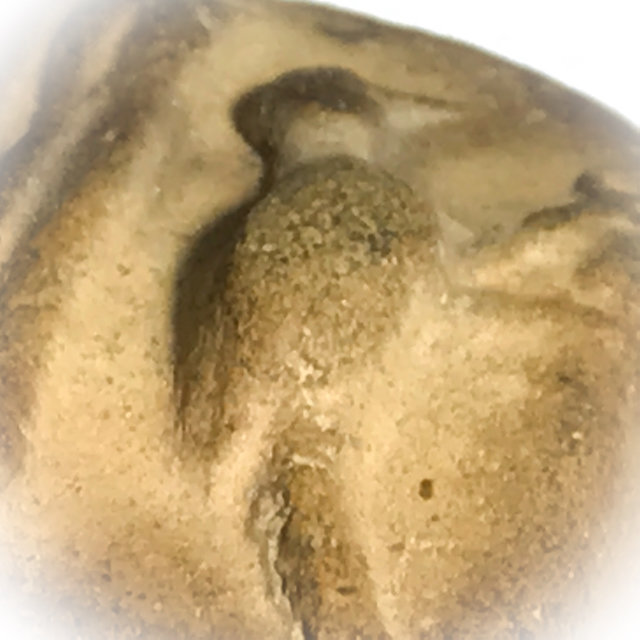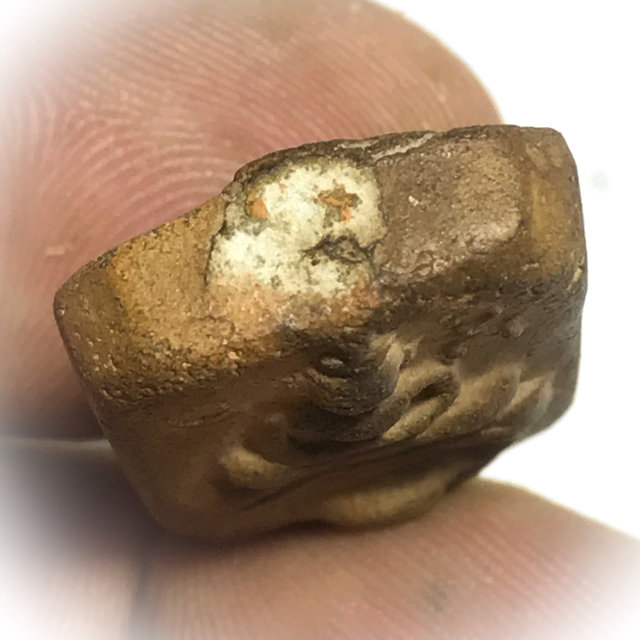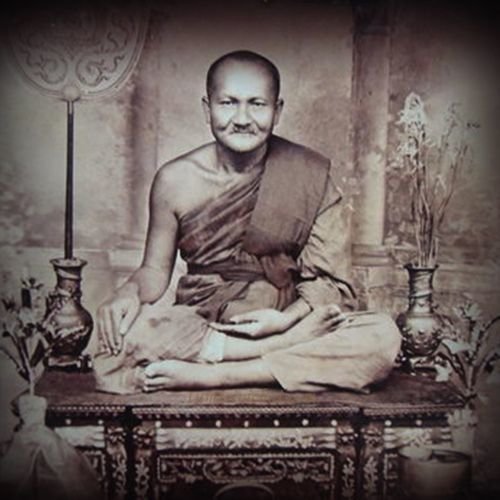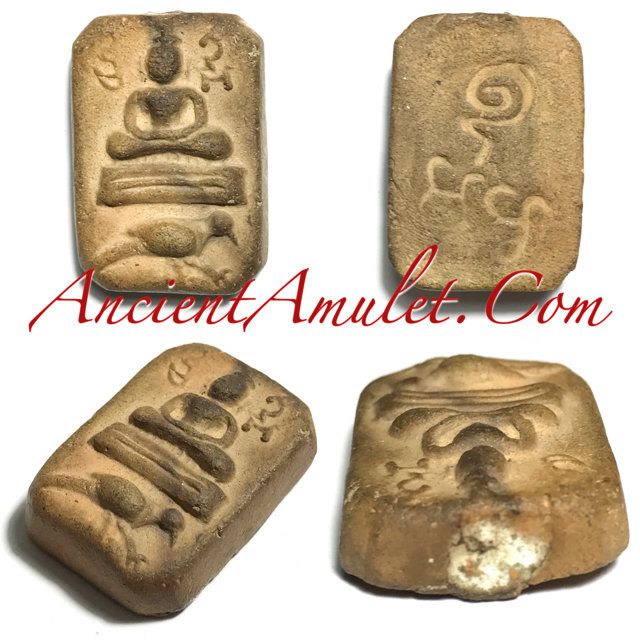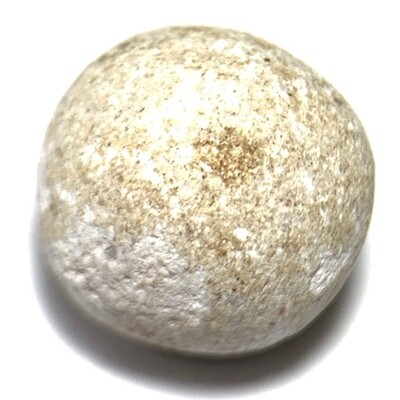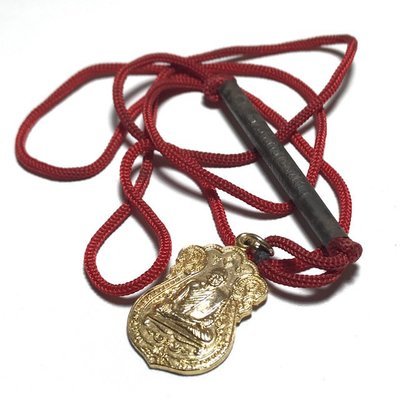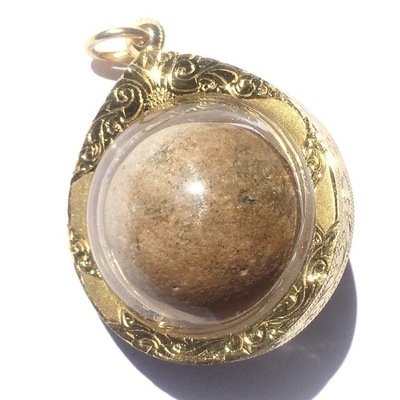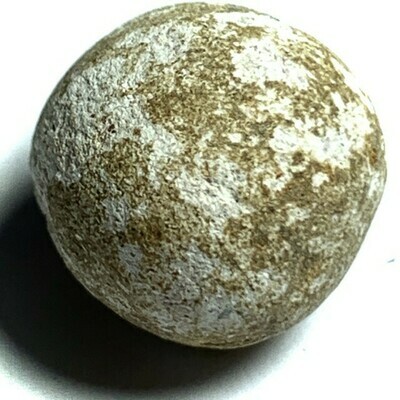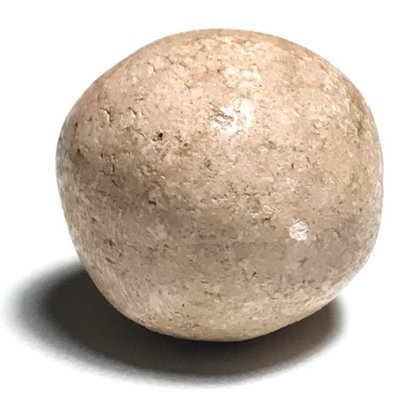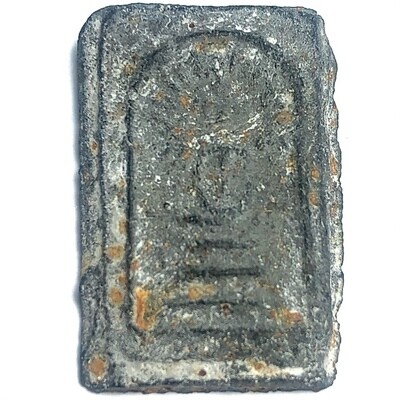Presenting a tiny but powerful and rare classic amulet from one of the Great Khao Or Masters of the 20th Century, Rian Glom Lek Hlang Chedi 2505 BE Nuea Tong Daeng Miniature Guru Monk Coin Por Tan Klai Wajasit
This Sacred amulet of the Great Khao Or Master of Nakorn Sri Tammarat, Master of Wat San Khan and Wat Pratat Noi, is a very rare amulet from Por Tan Klai’s 2505 BE Blessing Ceremony Edition, and is considered a ‘Jaek mae Krua’ type amulet (meaning ‘give to the kitchen maids and temple helpers’), which is suitable not only for men, but due to its miniature size, a perfect amulet for ladies or children to wear.

Rian Glom Lek 2505 BE Por Tan Klai Wajasit Wat Suan Khan
The 2505 BE edition of amulets of Por Tan Klai, is a highly preferred edition, which saw his famous ‘Rian Glom’ round Monk coin amulet with Chakra released, The Rian Glom Lek Hlang Chedi, and the Roop Tai Por Tan Klai Guru Monk Blesséd Photographamulets such as look om chan hmak and ya sen tobacco balls, and sacred powder amulets of various models.
A very rare and highly prized amulet for the devotees of Por Tan Klai to associate with his image and pray to him with a blessed image of the Guru, and the Chedi Relic Stupa on rear face for Buddhanussati and Marananussati. A powerful and Sacred amulet which has passed through the hands of the Guru and been blessed by him.
Por Tan Klai was one of the Top Guru Master Monks of the Last Century, and is considered one of the Four Great Masters of the Previous Generation of Lineage Masters of the Khao Or Southern Sorcery Lineage.
Kata Bucha Por Tan Klai
Pra Putta Jao Pratap Sadtw Khee Nok Pang Samati Thaan Khiang Pim Leuk 2460 BE - Luang Por Parn - Wat Bang Nom Kho
Pra Putta Jao Pratap Sadtw Samati Khee Nok Thaan Khiang Sam Chan Pim Leuk (Buddha over Bird on 3 tiered Lotus Dais ) - Luang Por Parn - Wat Bang Nom Kho (Amper Sena, Ayuttaya)
Top preferred model 'Pra Niyom' amulet from the world famous pantheon of 'Buddha Riding Animals' amulets of Luang Por Parn's 2460 BE edition. The Bird riding Buddha amulet of Luang Por Parn, was released in about ten different Pim (at least those which are accepted as Pra Niyom preferred category amulets).The amulets of Luang Por Parn are found in various coloured clays ranging from beige, brown, yellowish-white, reddish brown and terracotta red, as well as dark gray/blackish color. The amulet has Pong Wised sacred powders inserted into the top within a hollow of the amulet.
This model is the Pim Khee Nok Pang Samati Thaan Khiang Pim Leuk, which is a Niyom Class extremely preferred model, and has all the classic features expected within its 'Dtamni' (recognition points). This exhibit is in completely pristine condition and perfect details and features, making it Ongk Kroo Niyom 'preferred teacher masterpiece'. By 'teacher' we mean that the amulet contains all the classic expected features found in a truly accepted Pra Luang Por Parn.
This exhibit can most certainly be used as a reference model for study and comparison to confirm authenticity in other similar exhibits (helps you learn how to recognise authentic amulets of the same series). The rear face of the amulet has the classic Yant Ma A U embossed on it, which represents the Buddha ("Ma" for 'Moo Maha Sangko', meaning the Dhamma, "A" for 'Arahang', meaning the Buddha, and "U" for 'Uttama Tammo', meaning the Dhamma'.
There were six different kinds of Animals in the Dtamra of the 'Pra Putta Jao Pratap Sadtw' series of amulets made by Luang Por Parn, which he made after miraculous encounter with the Chee Ba Khaw Apparition who taught him this Wicha. It is said in Legend, that if you pray to the amulet and chant the Kata of Luang Por Parn for 3 Years, that the Animal will come to life and leave the amulet.
Officially, the general public know the amulets of Luang Por Parn to have been made in these 6 different kinds of Pim 1. Pim Song Gai (Cockerel) 2. Pim Song Krut (Garuda) 3. Pim Song Hanuman 4. Pim Song Pla 5. Pim Song Men and 6. Pim Song Nok
But this basic pantheon of six models, can be broken down into subdivisions to make up to more than 80 different Pim Song variations of the 6 basic design models. The full pantheon of over 80 different variations has still not yet been officially documented completely in official catalogues, and remains a difficult job for authors to compile and complete.
But in recent years, some aficionados have managed to find, photograph and document most of the more than 80 Pim Song, and the official catalogue is becoming finally more complete. This of course reveals that many models have not fallen into the hands of the monopolists, and that this has reopened the possibility for devotees to find an authentic amulet of Luang Por Parn.
Some models are of course so rare, that they are hardly ever seen, and this is one of the main reasons why it has taken so long to document and confirm their existence. it has taken many decades of diligent search and find by the aficionados, to slowly gather and document all the different models. For example the Pim Song Pla Jeen (Chinese Fighting Fish), has to main versions, the PIm Yai (large) and Pim Lek (small), as well as the PIm Pla Hmoo, which is extremely rare.
The PIm Song Khee Nok model has been found and documented to exist in about 10 different Pim Song, eight of which can be seen featured in the below image;
Its marks of authenticity, apart from knowing how to recognise the ingredients of the Sacred Powders and Muan Sarn in the amulet, and the signs of aging, are various;
- The head of the bird is rounded, the tail of the bird contacts with the outer edge of the amulet, the beak is pointed and slightly curved downwards
- The three tiered Dais has a slightly angled side on the left side of the dais, whereas the right side is vertical and straight. the 'waterfall' lines between the Buddha and the 3 tiered dais have 12 lines.
- The "U' Khom Agkhara on the left side of the Buddha's shoulder (our right), looks like a question mark (?), and connects with the top of the Khom Letter "A" below it
- The "U" Khom Agkhara Lettering above the Buddha's right shoulder (our left), flows down to connect with the top of the Khom Agkhara Letter "Ma" below it.
- The Prages topknot is very slightly tilted, and has a horizontal 'parasol shape' above the head of the Buddha.
This particular model is in a reddish-beige colored clay (classic), and possesses all the classic features of the 'Dtamni' (Athentication Marks) for classifying itself as a true prefferred class of Pim Niyom Amulet by Luang Por Parn, and is hence possible for entry into competition with confidence of a prize. Its clear cut refined details make it an easy amulet to recognise with little need of intensive scrutiny.
These days, few people can find themselves honored to have the chance to encounter such an amulet to possess for their own collection, for which reason this amulet needs no explanation as to why this is a most desirable acquisition to have in one's personal museum collection, and even more so, to be able to wear it and be under its protective inifluence and recieve its blessings.
A truly world famous classic amulet of the highest class and category, which anybody from the poor man to the millionaire will wear with pride and confidence of its magical powers. Who indeed does not wish to have a Luang Por Parn Wat Bang Nom Kho Buddha Amulet on their pendant chain around their neck? We would say that there is not a single amulet lover on the Planet who would not wish to wear such a sacred Ancient Amulet as this.
Biography of Luang Por Parn
Luang Por Parn Sunantoe's real Ordained Monk name was Pra Kroo Wiharagijjanugarn. He was born in 1875 (BE 2418.) , the youngest son of Mr. Aaj and Mrs. Im Sutawongs. During his younger age, he received the a nickname of " Parn " , because of a red Birthmark on the little finger of his left hand, which was seen as an unusual trait mark that linked with Buddhism.
Luang Por Parn received his Ordination as a Bikkhu (Buddhist Monk) on the First of April 1895 (BE 2438).
Luang Por Parn is worshiped as one of the Top 10 Greatest Guru Monks of present-day in Thailand & many worshippers all around the world. He was the closest disciple of Luang Por Niam Wat Noi, Suphanburi, and also a disciple of Luang Por Hnoeng, of Wat Klong Madarn. His two great teachers passed away with their bodies un-decayed.

Above; Luang Por Niam, Wat Noi.
When Luang Por Parn passed away in B.E.2480, his body was also un-decayed similar to his Guru teachers.

Above; Luang Por Hnoeng of Wat Klong Madan
In 1932, five years before he passed away, he announced to all his disciples the date and time of his death. His precognition was quite clear and exactly correct; he passed away on the date and time he had preannounced. Luang Por Parn was a meditative Guru Monk and also possessed magical knowledge. During Buddhist Dhamma, it was recorded that he reached the “ Great six knowledge of miracles ”. So he possesses knowledge on precognition, out-of-body ability, mind detecting, ability to do comprehensive paranormal phenomenal feats of magical prowess.

He was of course famous for the Wicha of the Yant Grao Paetch Diamond Armour Yantra Spell, and for the Kata which many International Devotees have come to know as the 'Rich Kata'. It is said that this Kata can make you immensely wealthy as a Millionaire if chanted constantly and regularly without fail.
The legends of the powers of his Yant Grao Paetch spell are known by devotees around the world to be perhaps the most powerful Invincibility Spell of all, as well as providing an extensive set of Buddhist Blessings for Luck, Karma Improvement, Prosperity, Protection against all Ailments and Dangers, and of course for Wealthy Fortunes.

Apart from this, he also possesses the highest state of “ Vipassana ” or knowledge of mind cleaning to stop next rebirth (Reincarnation). It was his great Dhamma practice that had cleaned and " distilled " his inner body (astral body) to crystal-like state which changed his body's cells immortal. Many great Guru Monks in Thailand hinted their Dhamma levels to their disciples in such way.
Luang Por Parn's famous amulets have marked long-time uncountable records in warding off dangers of all kinds. And it's great for making holy water for healing illness that modern physician not able to diagnose & cure. Luang Por Parn'samulets are extremely unique withBuddha sitting on a Garuda, Hanuman, Porcupine, Fish, Cockerel, and Bird.
Once Luang Por Parn told his disciples that his amulets had been blessed for a period of three months, it's long time more than enough to charge Buddha's power into amulets capable of warding off dangers of all kinds. He said that if they were blessed for 3 years, the Garuda and the Bird on the amulet would fly out. (A real life news reporting of bird image flew out from the amulet was published in a Malaysia Chinese newspaper; A shop’s CCTV of the amulet’s owner recorded the “ flying bird ” flying around his shop and flew back into the drawer where the amulet was kept.)
Luang Por Parn's amulets are very popular among Thai amulets users and collectors because of their frequent miraculous phenomena both recorded and unrecorded. After his Ordination, Luang Por Parnstayed at Wat Bang Pla Hmor to study Gammatan and Vipassana, along with various Buddha Magic methods under the Supervision of L.P. Sun; Specializing in the topics of curing illness, physical aches and pains, and also curing people who were under the bad influence of black magic &harmful spells.He attained the level of " Adept " extremely quickly.
He also spent 2 years studying " Bariyadti Dhamma " , and Pali Sanskrit language under the Supervision of"Ajarn Jeen", from Wat Jao Jed; then continued his studies at Wat Saket in Bangkok, until his completion in " Apitamm " (Abhidharma) 5 years later.
When in Bangkok, Luang Por Parn recieved extra training in Traditional Buddhist Medicine at Wat Sangwaes. Luang Por also recieved training in Gammatan from Luang Por Niyam of Wat Noy in Ampher Basng Pla Ma, Supannburi Province, for a period of three months. In addition, he was trained an extra month by LP Hnoeng, of Wat Klong Madan in Ampher Sorng Pi Norng, Supannburi. While in the forest, LP Parn received the secrets of creating Clay magical Amulets, in the form of a set of six different images from " CHI BA KHAW " . These 6 Amulets are the set of six Clay Buddha Amulets that are so revered and hard to find these days; considered by Disciples ofWat bang Nom Kho to possess extremely powerful magic.
The Secret of " Yant Grao Paetch " , or " Diamond Armour/Diamonjd Shield Yantra " as it has come to be known in the English language, was obtained from " Ajarn jaeng " , a lay Practitioner and Master of Yant and Buddha magic.
Kata Ngern Larn
PUTTA MA A U NA MŌ PUT TĀ YA WIRATAYŌ WIRAKŌNĀYANG WIRAHINGSĀ WIRATĀSĪ WIRATĀSĀ WIRA IDTHĪYŌ PUTTASSA MĀNĪ MĀMA PUTTASSA SWĀHŌM
T้he Kata should be chanted as you place alms in the bowl of a monk on alsmrounds, but if not possible, you should drop money into a moneybox which is used to keep the donations in, and when convenient, use to donate to Monks or a temple, or for Buddhism. The Devas will reward you with lucky fortunes, riches, and protect you from danger.
After completion of his training, Luang Por Parn inaugurated the Pali Sanskrit and Dharma school at Wat Bang Nom Kho. Apart from this, he assisted in the building and development of up to forty Temples around Thailand, including the additional construction of Shrines for other Temples that were already in existence(known as Bote in Thailand).
He is considered to have had to have possessed Extremely Great Virtues to have been able to attain the creation/construction of such institutions and enable the growth of Buddhism and spreading of the dharma on such a massive scale.
After Completion of his studies under Luang Por Sun, he performed " Tudongk " (Wandering alone deep through the Jungle). He wandered as far as the frontier to Burma, and encountered various strange Phenomena during his journey. Those strange encounters became legends, which are enough to fill a large book in themself. In fact, there is a 900 page book recounting the Tudong Tales of Luang Por Parn, which include sotries of his looksit Luang Por Ruesi Ling Dam of Wat Ta Sung, who was of course the Lineage Magic Inheritor and First Apprentice to Luang Por Parn at Wat Bang Nom Kho.
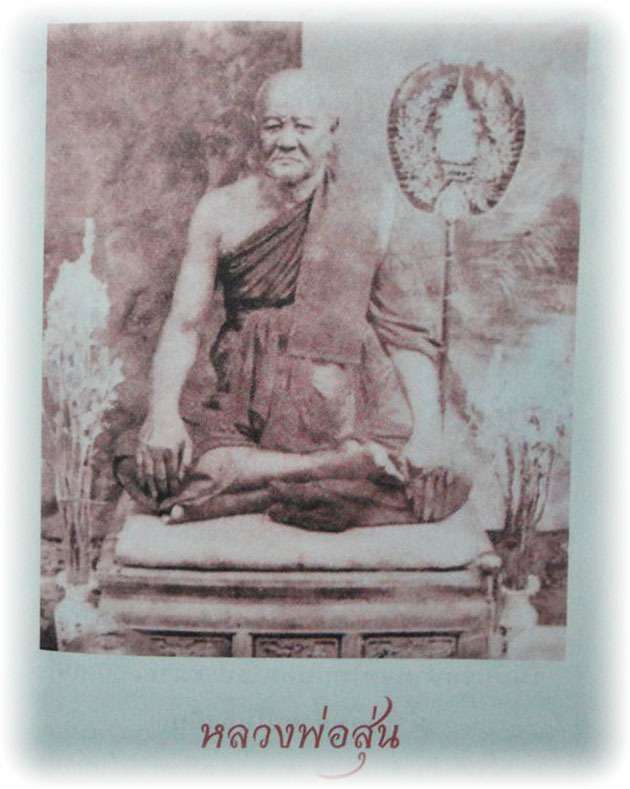
Above; Luang Por Sun of Wat Bang Pla Hmor
After his returning to Wat Bang Nom Kho, he performed Spiritual and Budhist medicinal healings for devotees who came with their problems. He treated the physical illness and also people under the in bad influence of Magical Spells and Curses. It is said that he who received treatment from Luang Por Parn was healed of his problem without any single exception !!!

Luang Por Parn had an extremely gentle appearance, with the Light complexion and aspect of a gentleman from the high society. His voice was soft, polite and pleasing to all ears. His mouth was always slightly curver upwards with a slight smile, and he possessed great compassion for both human and animals.
He didn’t separate social castes, receiving every visitor with the same compassionate and welcoming attitude, regardless of their social standing or ranking in the society. Social castes are irrelevant to him no matter one was a millionaire, a gentleman, royalty or a working class farmer or beggar. It is said that if a bad person, a thief, or drunkard paid a visit to Luang Por Parn, he would change his attitudes after visiting to Luang Por Parn, and became kinder, gentle and less wayward.
Luang Por Parn's daily routines when at Wat Bang Nom Kho; After the daily last meal at 11 am, he would rest a short while, after which, he would sit and receive visitors to help them with their requests. While waiting, he would prepare " Nam Mooh " (Prayer Water), for treating people with illnesses. There were an incredible number of people who came to see him in order to cure all sorts of illnesses, or were under the influence of Black Magic & Curses. Luang Por Parn treated people into the late hours, no matter how tired he might be.
Even though he is no longer with us, he has given Buddhist people and those who believe in his ultimate powers an inheritance of the Body, Soul, Mind & also Fortunes. Luang Por Parn was well known for his Buddha Magic and Buddhist medicine & healing methods. He created powerful amulets during the Buddhist year BE 2460 (1917). He was famous for finding the extremely well known and powerful Katha/ Yant (mantra) of Grao Paetch (Diamond Armour )in the Buddhist year BE 2458 whilst making a pilgrimage to Suphanburi province. Famous for his discovery of the Sacred Yant Grao Paetch Diamond Armour Yantra. LP Parn was very filial to his Mother and Father, who he cared for in their old age and times of illness.
Even though LP Parn was abbot of Wat Bang Nom Kho temple. He brought them to the Temple and allowed them to stay in his Guthi, taking care and feeding them, and often wash his mother's clothing, regardless of his High status and amount of work he had to perform, he always make up time to take care his Parent.
In Buddhist teachings, one's Mother is seen as the most sacred person in Life, due to the pain she goes through in giving “Birth” to us, the worry when our young age and care she has for us as her children. When praying in Buddhist belief, the lighting of 5 incense sticks has the meaning of dedication : first three sticks to the Triple gem (Buddha Dharma and Sangha) , the fourth stick is to dedicate to one's Mother and father, the fifth to the Kru / Ajarn, meaning Teacher/Master.
After returning to his hometown, Ayuttaya , Luang Por Parn became the third abbot of Wat Bang Nom Kho, because he had reached a very high level of meditation and the people there respected him very much and showed confidence on him.
Luang Por Parn returned to Wat Bang Nom Koh to teach the locals meditation and Buddha. He then rebuilt Wat Bang Nom Koh and turned it into a majestic temple.
Luang Por Parn also help to re-build as many as 41 others temples in Ayuttayah. In fact, Luang Por Parn had once met Ajahn Pon, an ordinary monk , and was curious to see him distributing money every day to different temples for sponsoring and helping to rebuilt temples everyday.
So Luang Por Parn asked him about his job and why he was so rich that he did not need to work ands went to temples everyday. Ajahn Pon replied that he had no job nut often chanted some incantations and this made him become rich.
In the beginning, Luang Por Parn was doubtful about Ajahn Pon's ability but as time went by, Ajahn Pon still donating to the temples. At last, Luang Por Parn believed Ajahn Pon's words and learned the incantations from him. They possess magical effects and can bring wealth as well as giving protection. Later, Luang Por Parn became famous for these incantations. Luang Por Parn had once said that he would be able to concentrate chanting these incantation regardless of whether he was walking or sitting. There was once a person asked Luang Por Parn what effects the incantations had. Luang Por Parn answered that if he chanted the incantations sincerely, the scriptures would make him become richer: if farmers chanted the incantations, they would have a good harvest, the quality and quantity of the crop yield would be better as well as avoiding insect pests and disasters.
For business people, their products would be saleable and for employees , they would work smoothly, be promoted or enjoy salary increment. As long as they are sincere, then they will be rewarded. The following are the incidents which are quite well known among the locals.
Luang Por Parn was a master that had many disciples. whenever Luang Por Parn needed money for temple used, his disciples from near and far would come to his aid. Most of the money spent on renovations came from the sales of amulets as well as donations from his disciples. Beside building temples, Luang Por Parn also helped villagers treat their sickness and free them from the spell. luang Por Parn would use holy water and herbs mixed with Pali scriptures, and meditation power to help the villagers. All the people who went to him would have their problems or illnesses solved in the end.

